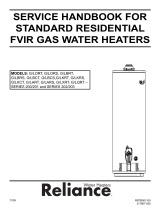
©Copyright Task Force Tips LLC 2011–2023 8 LIA-202 August 23, 2023 Rev06
TASK FORCE TIPS LLC
MADE IN USA · tft.com
3701 Innovation Way, Valparaiso, IN 46383-9327 USA
800-348-2686 · 219-462-6161 · Fax 219-464-7155
6.0 WARRANTY
Task Force Tips LLC, 3701 Innovation Way, Valparaiso, Indiana 46383-9327 USA (“TFT”) warrants to the original purchaser of its
products (“equipment”), and to anyone to whom it is transferred, that the equipment shall be free from defects in material and
workmanship during the five (5) year period from the date of purchase for mechanical components, and the two (2) year period from the
date of purchase for electrical components. TFT’s obligation under this warranty is specifically limited to replacing or repairing the
equipment (or its parts) which are shown by TFT’s examination to be in a defective condition attributable to TFT. To qualify for this limited
warranty, the claimant must return the equipment to TFT, at 3701 Innovation Way, Valparaiso, Indiana 46383-9327 USA, within a
reasonable time after discovery of the defect. TFT will examine the equipment. If TFT determines that there is a defect attributable to it,
TFT will correct the problem within a reasonable time. If the equipment is covered by this limited warranty, TFT will assume the
expenses of repair.
If any defect attributable to TFT under this limited warranty cannot be reasonably cured by repair or replacement, TFT may elect to
refund the purchase price of the equipment, less reasonable depreciation, in complete discharge of its obligations under this limited
warranty. If TFT makes this election, claimant shall return the equipment to TFT free and clear of any liens and encumbrances.
This is a limited warranty. The original purchaser of the equipment, any person to whom it is transferred, and any person who is an
intended or unintended beneficiary of the equipment, shall not be entitled to recover from TFT any consequential or incidental damages
for injury to person and/or property resulting from any defective equipment manufactured or assembled by TFT.
It is agreed and understood that the price stated for the equipment is in part consideration for limiting TFT’s liability. Some states do not
allow the exclusion or limitation of incidental or consequential damages, so the above may not apply to you.
TFT shall have no obligation under this limited warranty if the equipment is, or has been, misused or neglected (including failure to
provide reasonable maintenance) or if there have been accidents to the equipment or if it has been repaired or altered by someone else.
THIS IS A LIMITED EXPRESS WARRANTY ONLY. TFT EXPRESSLY DISCLAIMS WITH RESPECT TO THE EQUIPMENT ALL
IMPLIED WARRANTIES OF MERCHANTABILITY AND ALL IMPLIED WARRANTIES OF FITNESS FOR A PARTICULAR PURPOSE.
THERE IS NO WARRANTY OF ANY NATURE MADE BY TFT BEYOND THAT STATED IN THIS DOCUMENT.
This limited warranty gives you specific legal rights, and you may also have other rights which vary from state to state.
7.0 MAINTENANCE AND INSPECTION
The Pressure Relief Valve requires no routine maintenance but should be tested regularly. Since the Pressure Relief Valve may not need
to open in normal use, it is important that it be inspected at least quarterly for proper function per NFPA 1962 or annually per NFPA 1911,
depending on the application. In particular, assure that:
• There is no damage such as cracks or dents
• There is no corrosion
• Setting indications are readable
• The waterway is clear of obstructions
• The valve opens at the set pressure
If any problems are found, the Pressure Relief Valve should be removed from service until the problem is corrected. Any repaired
Pressure Relief Valve must be tested before being placed in service.
8.0 TESTING
It is important that your Pressure Relief Valve (PRV) is functioning properly at all times while in service. A properly functioning PRV
prevents dangerous situations and reduces possible injury. In order to ensure the PRV is functioning properly, it should be tested
regularly. NFPA standards set forth the minimum requirements and procedures for inspecting and testing these valves. It is strongly
recommended that you read and follow the procedures.
For PRVs mounted to piping of in-service emergency vehicles:
NFPA 1911: Inspection, Maintenance, Testing, and Retirement of In-Service Emergency Vehicles
For PRVs mounted to a fire hose appliance:
NFPA 1962: Standard for the Care, Use, Inspection, Service Testing, and Replacement of Fire Hose, Couplings, Nozzles, and Fire Hose
Appliances
Any valves taken out of service due to failure should be returned to the factory for repair or replacement. If you have any questions
regarding the testing or maintenance of your Pressure Relief Valve, please call Task Force Tips at 800-348-2686.









